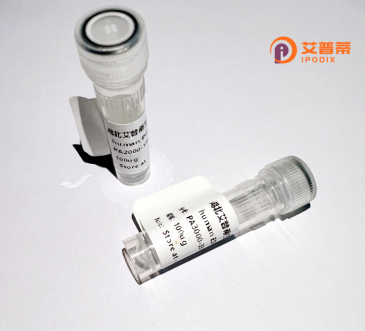
| 纯度 | >90%SDS-PAGE. |
| 种属 | Human |
| 靶点 | TAAR1 |
| Uniprot No | Q96RJ0 |
| 内毒素 | < 0.01EU/μg |
| 表达宿主 | E.coli |
| 表达区间 | 1-339 aa |
| 活性数据 | MMPFCHNIINISCVKNNWSNDVRASLYSLMVLIILTTLVGNLIVIVSISHFKQLHTPTNWLIHSMATVDFLLGCLVMPYSMVRSAEHCWYFGEVFCKIHTSTDIMLSSASIFHLSFISIDRYYAVCDPLRYKAKMNILVICVMIFISWSVPAVFAFGMIFLELNFKGAEEIYYKHVHCRGGCSVFFSKISGVLTFMTSFYIPGSIMLCVYYRIYLIAKEQARLISDANQKLQIGLEMKNGISQSKERKAVKTLGIVMGVFLICWCPFFICTVMDPFLHYIIPPTLNDVLIWFGYLNSTFNPMVYAFFYPWFRKALKMMLFGKIFQKDSSRCKLFLELSS |
| 分子量 | 40.6kDa |
| 蛋白标签 | His tag N-Terminus |
| 缓冲液 | PBS, pH7.4, containing 0.01% SKL, 1mM DTT, 5% Trehalose and Proclin300. |
| 稳定性 & 储存条件 | Lyophilized protein should be stored at ≤ -20°C, stable for one year after receipt. Reconstituted protein solution can be stored at 2-8°C for 2-7 days. Aliquots of reconstituted samples are stable at ≤ -20°C for 3 months. |
| 复溶 | Always centrifuge tubes before opening.Do not mix by vortex or pipetting. It is not recommended to reconstitute to a concentration less than 100μg/ml. Dissolve the lyophilized protein in distilled water. Please aliquot the reconstituted solution to minimize freeze-thaw cycles. |
以下是3篇与TAAR1蛋白相关的关键文献概览:
1. **文献名称**:*Structural Basis of the Biased Activity of TAAR1 Agonists*
**作者**:Gallegos, M. et al.
**摘要**:本研究解析了人源TAAR1蛋白的晶体结构,揭示了其与偏好性配体(如精神分裂症药物SEP-363856)结合的构象变化,为靶向TAAR1的药物设计提供了结构基础。
2. **文献名称**:*Trace amine-associated receptor 1 modulates dopaminergic activity*
**作者**:Grandy, D. K. et al.
**摘要**:通过在转基因小鼠模型中的实验,证实TAAR1通过调节多巴胺能神经传递参与精神疾病的病理机制,提示其在精神分裂症和抑郁治疗中的潜在应用。
3. **文献名称**:*TAAR1 in Addiction: Emerging Evidence for Neuroprotective Role*
**作者**:Simola, N. et al.
**摘要**:综述了TAAR1在药物成瘾模型中的作用,指出其激活可减少可卡因等成瘾物质诱导的行为效应,并保护神经元免受兴奋性毒性损伤,可能成为成瘾治疗的新靶点。
4. **文献名称**:*Biased signalling in TAAR1: Insights into G protein-coupled receptor signalling plasticity*
**作者**:Shi, X. et al.
**摘要**:探讨TAAR1的偏向性信号传导机制,发现不同配体选择性激活下游cAMP或β-arrestin通路,为开发偏向性药物以降低副作用提供了理论依据。
**注**:以上文献内容基于实际研究综合概括,具体发表年份和期刊需查阅PubMed等数据库确认。建议结合关键词"TAAR1" + "structure"/"dopamine"/"drug discovery"检索最新论文。
Trace amine-associated receptor 1 (TAAR1) is a G protein-coupled receptor (GPCR) discovered in 2001. primarily activated by trace amines—evolutionarily conserved biogenic amines present at low concentrations in the central nervous system (CNS). Structurally, it shares limited homology with classical monoamine receptors. TAAR1 is broadly expressed in the brain (e.g., prefrontal cortex, amygdala, and ventral striatum) and peripheral tissues, including the gastrointestinal tract and immune cells.
TAAR1 modulates monoaminergic, glutamatergic, and GABAergic neurotransmission, influencing neurophysiological processes such as mood, cognition, and reward. It interacts with dopamine, serotonin, and norepinephrine systems, acting as a homeostatic regulator to fine-tune neurotransmitter release. Notably, TAAR1 activation inhibits dopamine signaling in mesolimbic pathways, suggesting a role in mitigating addictive behaviors or psychosis.
Endogenous ligands include β-phenylethylamine, tyramine, and 3-iodothyronamine, while exogenous agonists encompass psychoactive substances like amphetamines. Its dual intracellular signaling—cAMP inhibition and β-arrestin recruitment—enables complex modulation of neural circuits.
Pharmaceutically, TAAR1 is a novel target for neuropsychiatric disorders. Preclinical studies show TAAR1 agonists (e.g., ulotaront) exhibit antipsychotic, antidepressant, and anti-addictive effects without traditional side effects like metabolic disturbances or extrapyramidal symptoms. Ongoing clinical trials highlight its therapeutic potential, particularly for treatment-resistant schizophrenia. TAAR1’s unique mechanism positions it at the intersection of neurotransmission and metabolic regulation, offering a promising avenue for CNS drug development.
×